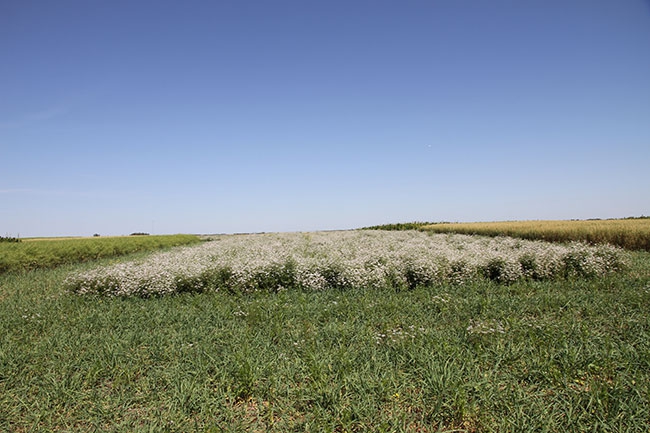
Features
Agronomy
Other Crops
Sequencing large acreage and special crops
Diversified crop rotations are an important component of western Canadian cropping systems. Although crops like wheat and canola are the largest acreage crops, adding special crops into the rotation helps manage weed, disease and insect pest problems and potential resistance issues, improves soil health and maximizes profitability. However, determining which crop fits best in the cropping sequence remains a big question.
March 24, 2017 By Donna Fleury
 Crop sequencing plots of large acreage and special crops at Indian Head Diversified crop rotations are an important component of western Canadian cropping systems.
Crop sequencing plots of large acreage and special crops at Indian Head Diversified crop rotations are an important component of western Canadian cropping systems.“Special crops provide producers with opportunities to diversify, both in crops and in value-added enterprises – however, more agronomic information is needed for these crops,” explains Bill May, crop management agronomist with Agriculture and Agri-Food Canada in Indian Head, Sask.
In 2015, May launched a four-year crop sequencing study at four locations in Saskatchewan to try to find some answers. The project includes eight different crops grown in various sequences to determine moisture and residual nitrogen (N), plant density, volunteers (counts and biomass), disease ratings, grain yield and grain quality. The eight crops are wheat, oat, canola, pea, canaryseed, hemp, quinoa and coriander. The locations – Indian Head, Melfort, Saskatoon and Swift Current – are representative of growing conditions across Saskatchewan.
“We are really just getting underway with the project and have very preliminary data at this point,” May says. “The study is quite complex, and with four replications at each site, there will be 256 plots to evaluate and analyze each season. In year one, all eight crops are seeded in plots in one direction and replicated four times at each location. In year two, the same eight crops are seeded perpendicular to the previous year plots to try to determine the impacts on the various factors being studied of each preceding crop on the following crop. This two-year crop sequence protocol is repeated at each location over the length of the project. One of the key aspects will be monitoring volunteers for each crop to see how big an issue that is in the mix and also doing a weed count and analyzing the impacts on yield and quality.”
May says the project is in very early days and results to date are very preliminary. Like any project, there have been a few challenges to address along the way. Hemp presents one of the biggest challenges, thanks to the onerous regulations governing research, particularly on multiple sites. The regulations tend to be focused on single projects on single sites, so the approval process and paperwork for a multi-site project require a huge investment of time and effort.
Some of the special crops present both growing and management challenges. Although quinoa germinated well in the first year, in 2016 there were some germination problems that may have been seed-related. “We try to use the recommended seeding rate and fertilizers for each crop, along with recommended disease control,” May says. “In 2016, blossom blight in coriander was a serious disease problem, but unfortunately we were unable to apply disease control on time. We have adjusted the protocols for coriander and know for next year that if we have to apply fungicide for coriander, it must be applied at the early blossom stage. We are gaining experience with all of the different agronomics for these very different crops.”
What May really wants to find out is which crop combinations do well when preceded by certain crops. For example, in 2016 canola did not seem to like coriander as a previous crop at one site. Although this is an unlikely sequence, the study is trialing all of the crops on each other to understand the issues. One of the challenges with growing a crop like canola on coriander is volunteers and their management. In Indian Head, the oat on oat combination did not perform well at all.
At the end of the project, there will be three years of sequencing data at four sites across Saskatchewan. Researchers expect to provide good information on what combinations and sequences work best at each location. Watch for interim results in 2017 and final results at the end of the project in 2018.